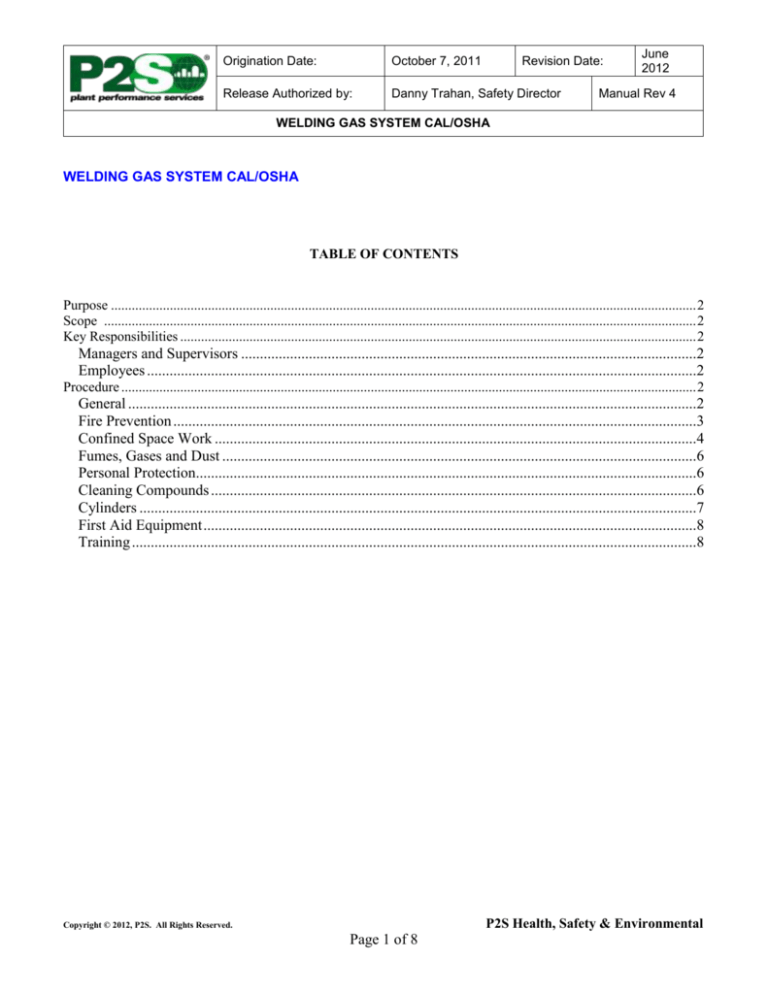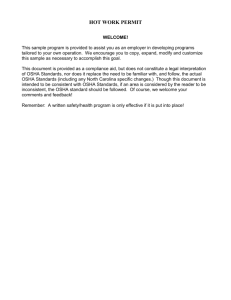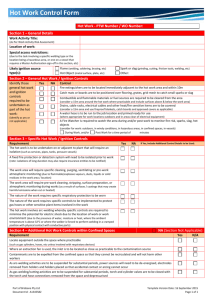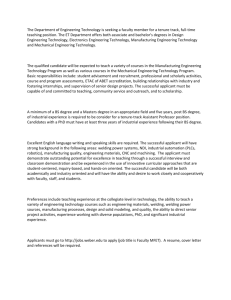
Origination Date:
October 7, 2011
Revision Date:
Release Authorized by:
Danny Trahan, Safety Director
June
2012
Manual Rev 4
WELDING GAS SYSTEM CAL/OSHA
WELDING GAS SYSTEM CAL/OSHA
TABLE OF CONTENTS
Purpose ......................................................................................................................................................................... 2
Scope ........................................................................................................................................................................... 2
Key Responsibilities ..................................................................................................................................................... 2
Managers and Supervisors .........................................................................................................................2
Employees ..................................................................................................................................................2
Procedure ...................................................................................................................................................................... 2
General .......................................................................................................................................................2
Fire Prevention ...........................................................................................................................................3
Confined Space Work ................................................................................................................................4
Fumes, Gases and Dust ..............................................................................................................................6
Personal Protection.....................................................................................................................................6
Cleaning Compounds .................................................................................................................................6
Cylinders ....................................................................................................................................................7
First Aid Equipment ...................................................................................................................................8
Training ......................................................................................................................................................8
P2S Health, Safety & Environmental
Copyright © 2012, P2S. All Rights Reserved.
Page 1 of 8
Origination Date:
October 7, 2011
Revision Date:
Release Authorized by:
Danny Trahan, Safety Director
June
2012
Manual Rev 4
WELDING GAS SYSTEM CAL/OSHA
Purpose
The purpose of this program is to assure a safe work environment during welding, cutting and hot work operations
in California. Gas welding, cutting and heating shall be conducted in accordance with Cal/OSHA California Code
of Regulations, Title 8.
Scope
This program is applicable to all P2S employees directly involved or assisting in the welding, cutting and hot work
operations in California.
Key Responsibilities
Managers and Supervisors
Determine if its property is safe for welding and cutting operations.
Establish safe areas for welding and cutting operations.
Provide training for all employees whose task includes heat, spark or flame producing operations such as
welding, brazing, or grinding.
Develop and monitor effective hot work procedures.
Provide safe equipment for hot work.
Provide proper and effective PPE for all hot work.
Monitor all hot work operations.
Ensure all hot work equipment and PPE are in safe working order.
Allow only trained and authorized employees to conduct hot work and conduct inspections of the hot work
area before operations begin.
Employees
Follow all hot work procedures.
Properly use appropriate hot work PPE.
Inspect all hot work equipment before use.
Report any equipment problems or unsafe conditions.
Procedure
General
Rules and instructions covering the operation and maintenance of fuel-gas supply equipment are readily available.
Rules and instructions covering the operation and maintenance of oxygen or fuel-gas supply equipment including
generators, and oxygen or fuel-gas distribution piping systems shall be readily available.
Cutting or welding shall not be permitted in the following situations:
In areas not authorized by management.
P2S Health, Safety & Environmental
Copyright © 2012, P2S. All Rights Reserved.
Page 2 of 8
Origination Date:
October 7, 2011
Revision Date:
Release Authorized by:
Danny Trahan, Safety Director
June
2012
Manual Rev 4
WELDING GAS SYSTEM CAL/OSHA
In sprinkled buildings while such protection is impaired.
In the presence of potentially explosive atmospheres, e.g. flammables.
In areas near the storage of large quantities of exposed, readily ignitable materials.
In areas where there is dust accumulation of greater than 1/16 inch within 35 feet of the area where
welding/hot work will be conducted.
All dust accumulation shall be cleaned up before welding or hot work is permitted.
Employees in charge of the oxygen or fuel-gas supply equipment shall be instructed for this work before the work
begins. Employees in charge of the oxygen or fuel-gas supply equipment including generators, and oxygen or fuelgas distribution piping systems shall be instructed for this work before being left in charge.
Back flow protection shall be provided by an approved device that will prevent oxygen from flowing into the fuelgas system or fuel from flowing into the oxygen system.
An approved device that will prevent flame from passing into the fuel-gas system shall provide flashback
protection.
An approved pressure-relief device set at the appropriate pressure shall provide backpressure protection.
Only approved apparatuses such as torches, regulators or pressure-reducing valves, setting generators and
manifolds shall be used.
A safety method used will consist of connecting a regulator to a cylinder valve using the "cracking" method away
from possible sources of ignition and while standing to one side of the outlet. Before connecting a regulator to a
cylinder valve, the valve shall be opened slightly and closed immediately. (This action is generally termed
"cracking" and is intended to clear the valve of dust or dirt that might otherwise enter the regulator.) The valve shall
be opened while standing to one side of the outlet; never in front of it. A fuel-gas cylinder valve shall never be
opened up, cracked near other welding work or near sparks, flame, or other possible sources of ignition.
All hoses and hose connections shall comply with the Compressed Gas Association and Rubber Manufacturers'
Associations' applicable standards.
Fire Prevention
COMPANY will ensure fire prevention and suppression procedures whenever any welding and cutting operations
are taking place are used. A fire prevention and suppression procedure shall be established whenever any welding
and cutting operations are taking place.
Whenever welding or cutting is performed in locations where other than a minor fire might develop or any of the
conditions mentioned above cannot be met, a fire watch shall be provided.
The fire watch shall be provided during and for a minimum of 1/2 hour past the completion of the welding
project.
The fire watch shall be trained in the use of fire extinguishers and the facility's alarm system.
During this time the fire watch will have appropriate fire extinguishers readily available.
Suitable extinguishers shall be provided and maintained ready for instant use.
P2S Health, Safety & Environmental
Copyright © 2012, P2S. All Rights Reserved.
Page 3 of 8
Origination Date:
October 7, 2011
Revision Date:
Release Authorized by:
Danny Trahan, Safety Director
June
2012
Manual Rev 4
WELDING GAS SYSTEM CAL/OSHA
A hot-work permit will be issued on all welding or cutting outside of the designated welding area.
A hot work permit must be completed before performing hot work. Precautions that are to be taken shall be in the
form of a written permit. Before cutting or welding is permitted the area shall be inspected and a written permit
shall be used to authorize welding and cutting operations.
Where practicable all combustibles shall be relocated at least 35 feet from the work site. Where relocation is
impractical, combustibles shall be protected with flameproof covers, shielded with metal, guards, curtains, or wet
down the material to help prevent ignition of material.
Ducts, conveyor systems, and augers that might carry sparks to distant combustibles shall be protected or shut
down. Where cutting or welding is done near walls, partitions, ceilings, or openings in the floor (grating, manholes,
etc.), fire-resistant shields or guards shall be provided to prevent ignition.
If welding is to be done on a metal wall, partition, ceiling, or solid decking/flooring, precautions shall be taken to
prevent ignition of combustibles on the other side, due to conduction or radiation of heat. Where combustibles
cannot be relocated on the opposite side of the work, a fire watch person shall be provided on the opposite side of
the work.
Cutting or welding on pipes or other metal in contact with combustible walls, partitions, floors, ceilings, or roofs
shall not be undertaken if the work is close enough to cause ignition by combustion.
A designated welding area shall be established to meet the following requirements:
Floors swept and cleaned of combustibles within 35 feet of work area.
Flammable and combustible liquids and material will be kept 35 feet from work area.
Adequate ventilation providing 20 air changes per hour.
At least one 10 pound dry chemical fire extinguisher shall be within access of 35 feet of the work area.
Protective dividers such as welding curtains or noncombustible walls will be provided to contain sparks and
slag to the combustible free area.
Requirements for welding conducted outside the designated welding area:
Portable welding curtains or shields must be used to protect other workers in the welding area.
A hot-work permit must be completed and complied with prior to initiating welding operations.
Respiratory protection is mandatory unless an adequate monitored airflow away from the welder and others
present can be established and maintained.
Plastic materials must be covered with welding tarps during welding procedures.
Fire watch must be provided for all hot-work operations.
After welding operations are completed, the welder shall mark the hot metal or provide some other means of
warning other workers.
Confined Space Work
A confined space is:
P2S Health, Safety & Environmental
Copyright © 2012, P2S. All Rights Reserved.
Page 4 of 8
Origination Date:
October 7, 2011
Revision Date:
Release Authorized by:
Danny Trahan, Safety Director
June
2012
Manual Rev 4
WELDING GAS SYSTEM CAL/OSHA
A space that Is large enough and so configured that an employee can bodily enter and perform assigned
work;
Has limited or restricted means for entry or exit (for example, tanks, vessels, coolers, storage bins, hoppers,
vaults, and pits are spaces that may have limited means of entry); and
Is not designed for continuous occupancy.
Refer to Confined Space Program for P2S before commencing any welding, cutting, and/or brazing operations in an
area meeting the requirements of a confined space.
Ventilation is a prerequisite to work in confined spaces.
When welding or cutting is being performed in any confined spaces, cylinders containing oxygen or acetylene, or
other fuel gases are not allowed to be taken in a confined space. Cylinders containing oxygen or acetylene or other
fuel or gas shall not be taken into confined spaces.
When a welder must enter a confined space through a manhole or other small opening, means shall be provided for
quickly removing him in case of an emergency. When safety belts and lifelines are used for this purpose, they shall
be so attached to the welder's body that it cannot be jammed in a small exit opening. An attendant with a
preplanned rescue procedure shall be stationed outside to observe the welder at all times and be capable of putting
rescue operations into effect.
In order to eliminate the possibility of gas escaping through leaks of improperly closed valves, when gas welding or
cuffing, the torch valves shall be closed and the fuel-gas and oxygen supply to the torch positively shut off at some
point outside the confined area whenever the torch is not to be used for a substantial period of time, such as during
lunch hour or overnight. If practical, the torch and hose shall also be removed from the confined space.
When welding must be performed in a space entirely screened on all sides, the screens shall be so arranged that no
serious restriction of ventilation exists. It is desirable to have the screens so mounted that they are about 2 feet (0.61
m) above the floor unless the work is performed at so low a level that the screen must be extended nearer to the
floor to protect nearby workers from the glare of welding.
All welding and cutting operations carried on in confined spaces shall be adequately ventilated to prevent the
accumulation of toxic materials or possible oxygen deficiency. This applies not only to the welder, but also to
helpers and other personnel in the immediate vicinity. All air withdrawn will be replaced with air that is clean.
In circumstances for which it is impossible to provide such ventilation, airline respirators or hose masks approved
for this purpose by the National Institute for Occupational Safety and Health (NIOSH) will be provided. In areas
immediately hazardous to life, a full-face piece, positive pressure, self-contained breathing apparatus or a
combination full-face piece, positive pressure supplied-air respirator with an auxiliary, self-contained air supply
approved by NIOSH must be used.
Where welding operations are carried on in confined spaces and where welders and helpers are provided with hose
masks, hose masks with blowers or self-contained breathing equipment, a worker shall be stationed on the outside
of such confined spaces to ensure the safety of those working within.
P2S Health, Safety & Environmental
Copyright © 2012, P2S. All Rights Reserved.
Page 5 of 8
Origination Date:
October 7, 2011
Revision Date:
Release Authorized by:
Danny Trahan, Safety Director
June
2012
Manual Rev 4
WELDING GAS SYSTEM CAL/OSHA
Fumes, Gases and Dust
Fumes produced by some welding processes can be toxic and may require source extraction. An assessment of the
work to be performed must be completed before each job is undertaken. Fumes generally contain particles from the
material being welded. Welding fumes can have an acute effect on the respiratory system.
All welding and cutting operations shall be adequately ventilated to prevent the accumulation of toxic materials.
This applies not only to the welder, but also to helpers and other personnel in the immediate vicinity.
P2S shall institute procedures to be used when possible evolution's of hazardous fumes, gases or dust to the metals
involved may exist. Any welding, cutting or burning of lead base metals, zinc, cadmium, mercury, beryllium or
exotic metals or paints not listed here shall have proper ventilation or respiratory protection. Refer to California
Division of Occupational Safety and Health – Title 8 Regulations Subchapter 4, Construction Safety Orders, Article
4 - Dusts, Fumes, Mists, Vapors, and Gases for a complete list
Welders and helpers will refer to the Respiratory Protection Program for P2S to determine the appropriate
respiratory protection to be used during welding operations.
Personal Protection
Helmets and hand shields shall be made of a material, which is an insulator for heat and electricity. Helmets,
shields, and goggles shall not be readily flammable and shall be capable of withstanding sterilization.
Helmets and hand shields shall be arranged to protect the face, neck and ears from direct radiant energy from the
arc.
Helmets shall be provided with filter plates and cover plates designed for easy removal.
All parts shall be constructed of a material, which will not readily corrode or discolor the skin.
Goggles shall be ventilated to prevent fogging of the lenses as much as practicable.
All glass for lenses shall be tempered, substantially free from scratches, air bubbles, waves and other flaws. Except
when a lens is ground to provide proper optical vision correction, the front and rear surfaces of lenses and windows
shall be smooth and parallel.
Lenses shall bear some permanent distinctive marking which may readily identify the source and shade and be
appropriate shade number for the application of work.
Adequate hand protection and clothing must be used to protect the body from welding hazards.
Cleaning Compounds
In the use of cleaning materials, because of their possible toxicity or flammability, appropriate precautions such as
manufacturer instructions shall be followed.
Degreasing and other cleaning operations involving chlorinated hydrocarbons shall be so located that no vapors
from these operations will reach or be drawn into the atmosphere surrounding any welding operation. In addition,
P2S Health, Safety & Environmental
Copyright © 2012, P2S. All Rights Reserved.
Page 6 of 8
Origination Date:
October 7, 2011
Revision Date:
Release Authorized by:
Danny Trahan, Safety Director
June
2012
Manual Rev 4
WELDING GAS SYSTEM CAL/OSHA
trichloroethylene and perchloroethylene shall be kept out of atmospheres penetrated by the ultraviolet radiation of
gas-shielded welding operations.
Cylinders
Compressed gas cylinders shall be DOT-approved and legibly marked near the shoulder of the cylinder for the
purpose of identifying the gas content with either the chemical or trade name of the gas.
All compressed gas cylinder connections must comply with ANSI B57. 1-1965 Standards.
Compressed gas cylinders shall be in the upright position during use and storage. Welding fuel-gas cylinders shall
be placed with valve end up whenever they are in use. Liquefied gases shall be stored and shipped with the valve
end up.
All cylinders shall be kept away from sources of heat and from radiators and piping systems that may be used for
grounding purposes.
Cylinders and cylinder valves including couplings and regulators shall be kept free from oily or greasy substances
and must not be handled with gloves or rags in the same condition.
Cylinders shall be handled carefully. Note: Rough handling, knocks and falls are liable to damage the cylinder,
valve or safety devices and result in leakage.
Stored oxygen cylinders shall be kept at least 20 feet from the fuel gas cylinders or combustible materials,
especially oil or grease, or separated by a non-combustible barrier at least 5 feet high with a fire rating of at least
one-half hour. All empty cylinders shall have closed valves. Valve protection caps shall always be in place and
hand-tight except when cylinders are in use or connected for use.
Cylinders shall not be kept in unventilated enclosures such as lockers and cupboards.
Cylinders with defective safety devices or leaking fuse plugs be plainly tagged, the supplier notified and warning
signs placed around the area to prohibit approach of an ignition source. Cylinders having leaking fuse plugs or
other leaking safety devices shall be plainly tagged and the supplier shall be promptly notified of the condition and
his instructions followed. A warning shall be placed near the cylinders prohibiting any approach to them with a
lighted cigarette or other source of ignition.
Assigned storage spaces shall be located where cylinders cannot be knocked over or damaged by falling objects or
subject to tampering by unauthorized persons.
Special care must be taken when transporting gas cylinders:
Cylinders must be secured with valve cap installed.
Cylinders shall not be lifted by the valve protection caps, the regulators must be removed and cylinders
shall not be dropped or permitted to strike each other.
Removed regulators must be carried in the cab of the vehicle.
Cylinders shall not be tampered with nor should any attempt be made to repair them.
P2S Health, Safety & Environmental
Copyright © 2012, P2S. All Rights Reserved.
Page 7 of 8
Origination Date:
October 7, 2011
Revision Date:
Release Authorized by:
Danny Trahan, Safety Director
June
2012
Manual Rev 4
WELDING GAS SYSTEM CAL/OSHA
First Aid Equipment
First aid equipment shall be available at all times. All injuries shall be reported as soon as possible for medical
attention. First aid shall be rendered until medical attention can be provided.
Training
Training shall include:
Position Responsibilities
Cutters, welders and their supervisors must be suitably trained in the safe operations of their equipment and
the safe use of the process.
Fire Watch Responsibilities - specifically, the fire watch must know:
o That their ONLY duty is Fire Watch.
o When they can terminate the watch.
o How to use the provided fire extinguisher(s).
o Be familiar with facilities and how to activate fire alarm, if fire is beyond the incipient stage.
o Operator Responsibilities
o Contractor Responsibilities
o Documentation requirements
o Respirator Usage requirements
o Fire Extinguisher training.
P2S Health, Safety & Environmental
Copyright © 2012, P2S. All Rights Reserved.
Page 8 of 8








